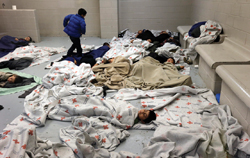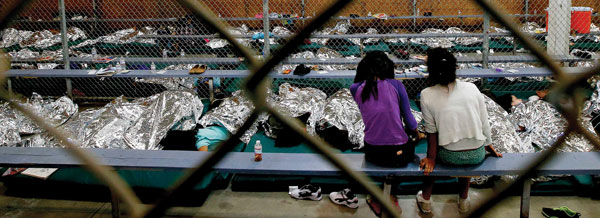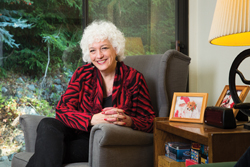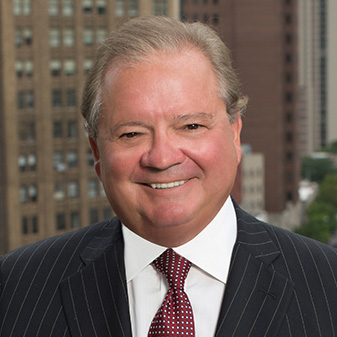Lawyers and judges face hurdles in struggle to cope with influx of young immigrants

Legal Limbo: Immigrant minors from Central America—fleeing violence, poverty and food shortages in their native countries—sleep at a U.S. Customs and Border Protection facility in Brownsville, Texas. Federal and state authorities are stretching resources to provide them with food and shelter, while advocates attempt to provide legal aid. Photo by Associated Press.
But last summer, law enforcement trainees were replaced by young children and their mothers. As the huge number of people fleeing Central America overwhelmed the one federal facility for immigrant families, the government repurposed the Artesia center as a 700-bed detention center for immigrant families with young children.
There, parents—mostly mothers—with young children wait weeks or months to find out whether their long, dangerous journeys north will end with permission to stay in the United States. Most are coming from the "northern triangle" countries of Central America—El Salvador, Guatemala and Honduras—where entire neighborhoods have been captured by violent gangs that governments can't control. Some of the families are also fleeing extreme poverty or domestic violence that the police at home don't take seriously.
Once they arrive at Artesia, detainees can't leave. As of August, the only phones they could use were cellphones carried by guards. Because Artesia is so far from large cities, no nonprofits in the area can offer them direct representation. Very few detainees speak English, and as newcomers to the United States, they're unlikely to understand how to defend themselves from deportation.
That situation attracted the attention of the American Immigration Lawyers Association, which launched a pro bono project in Artesia. AILA staff members say they chose Artesia because the temporary shelter offered so few legal protections.
For example, detainees are given a list of three legal aid organizations that might provide legal help. But one doesn't handle asylum, which is the detainees' most likely defense to removal, says Reid Trautz, director of AILA's Practice and Professionalism Center. All of those are three hours away in El Paso.
"And the guards are mostly men, and [the women] don't want to ask to use the phone," says Trautz of Washington, D.C, who is active in the ABA's Law Practice Management Section. "And even when they
have been trying to call, the two providers on the list are overwhelmed. That's why we went down there—to try to fill that vacuum before those people are removed."
But once there, pro bono lawyers struggled to keep up with a staggering caseload. Not only were there about 120 detainees per volunteer, they said, but their cases were on a faster track as compared with ordinary removal cases.
And in a lawsuit filed in D.C. federal court in August, immigrant advocates charged that the federal government made things worse. The lawsuit, M.S.P.C. v. Johnson, claimed authorities actively interfered in attorneys' attempts to help, asked misleading questions in asylum interviews and denied viable asylum cases. Officials speeded deportations to "send a message" to potential immigrants, the complaint said, in violation of the Immigration and Nationality Act and the due process clause of the Fifth Amendment. These practices left pro bono attorneys scrambling to stop deportations they believed avoidable.
"We're catching cases literally sometimes just a few hours before deportation and saying 'Oh, my God, you missed this'" important defense, says Laura Lichter, a past president of AILA.

Reid Trautz: Providers of legal aid for immigrant minors are often overwhelmed with cases. Photo by David Hills.
LOGISTICAL NIGHTMARE
Meanwhile, in Harlingen, Texas, the influx of immigrant minors was also causing struggles for the South Texas Pro Bono Asylum Representation Project, part of the ABA's Commission on Immigration. The ProBAR Children's Project had more than tripled its staff's size over three years to deal with the extra kids, says Meghan Johnson, its managing attorney. Administrative capacity was still catching up in August, which she says felt like "emergency mode" all the time.And to make matters worse, she says children were finding outside adult sponsors so quickly that ProBAR was unable to find time to work with them.
"Kids are moving out of our shelters too fast for us to be able to make any meaningful contacts with them or work for any extended period of time on their cases," she says.
As unaccompanied immigrant minors flooded into the U.S. this summer, immigration lawyers and judges struggled to keep up. The sheer number of minors arriving brought court scheduling problems, sudden changes in federal policy and more volunteers than legal aid organizations could handle. Often, these could be traced back to long-standing problems with the immigration legal system, including chronic underfunding of the immigration courts and the lack of a right to court-appointed counsel.
"It's really stretching our capacity quite a bit," says Wendy Young, president at Kids in Need of Defense, a nonprofit that represents unaccompanied immigrant children. "And I think there's a lot of tremendous goodwill in the legal community to do more pro bono for these kids. But it's also important to have an infrastructure to support those volunteers."
Although the surge of unaccompanied immigrant minors from Central America hit the news in 2014, immigration lawyers say it had been building for several years. The Vera Institute of Justice reported in 2012 that 6,092 unaccompanied minors entered U.S. custody in 2009 and 8,207 in 2010. These were in line with averages. But starting in FY2012, according to a February report from University of California's Hastings College of the Law in San Francisco and Kids in Need of Defense, the numbers started to creep up: 13,625 in FY2012, 24,668 in FY2013, and according to Customs and Border Protection, 66,127 in the first 11 months of FY14. The growth in immigrant families may be newer; CBP said "family unit apprehensions" grew by 412 percent between FY2013 and the first 11 months of FY2014.
Most are the teens from the violence-torn northern triangle of Central America. According to a March report from the Office of the U.N. High Commissioner for Refugees, kids interviewed about their reasons for leaving most often cited gang violence, including forced recruitment into gangs, and family reunification. The Women's Refugee Commission, in a 2012 report, says Guatemalans are also trying to escape food shortages caused by widespread poverty and a series of poor harvests. Some of the kids have left parents behind; others are orphans or abandoned. According to the UNHCR, 36 percent have one or both parents in the United States.

Wendy Young: Infrastructure is needed to support pro bono aid for immigrant minors. Photo by David Hills.
HELD UNTIL HEARING
Kids from contiguous countries—Mexico and Canada—may be deported after a screening by CBP officers for trafficking or asylum claims. But the Trafficking Victims Protection Reauthorization Act of 2008 entitles minors from other countries to a formal hearing.That means they have to stay in the U.S. until that hearing can take place. And the immigration courts have a huge backlog—408,037 pending cases as of August, according to federal data collected by Syracuse University's Transactional Records Access Clearinghouse.
Pursuant to the TVPRA, unaccompanied minors are transferred to shelters run by the Office of Refugee Resettlement under the U.S. Department of Health and Human Services.
ORR takes care of them until they can be placed with a safe adult sponsor. The non-partisan Vera Institute of Justice puts the average stay in ORR custody at 61 days in 2012; Johnson says it was more like 20 days in the summer of 2014.
Nonetheless, with the huge increase in kids, ORR quickly ran out of space in its existing facilities. That's why it opened three temporary shelters this summer at military bases in California, Oklahoma and Texas.
The on-base facilities were closed in early August, but Artesia and a family detention center in Texas remained open as of October.
In July, a delegation of leaders from the American Bar Association, including current President William Hubbard, then-President James Silkenat and personnel from the Commission on Immigration, visited the ORR shelter at Lackland Air Force Base in San Antonio. They also visited the city's immigration court.
Though it took a while to draw out the kids the delegation talked with, Silkenat describes the personal stories they did share as "horrific": threats of murder, rape and other violence to them and their families.
"We got to talk to a number of them and hear their stories about why they left where they were, how they got through to the U.S., being picked up at the border or shortly thereafter, their understanding or lack of it of what was now going to happen to them," he says. It was a "really emotionally charged atmosphere, I think not only for them but for those of us who got to participate in their series of meetings."
"One of the more dramatic episodes was meeting with some of the young girls in one of the facilities," he says. "They'd only learned that morning that their situation was now going to go before a judge, and there was a process here and it might result in them not getting to stay in the U.S."
In response, the ABA formed the Working Group on Unaccompanied Minor Immigrants to recruit, train and mentor additional attorneys to aid existing legal service programs. In an Oct. 20 letter to Vice President Joe Biden describing the new group, Hubbard said "the demand for pro bono services outweighs the available resources." Hubbard also suggested that the government continue to fund the Department of Health and Human Services' Legal Access Project, which supplies children with pres-entations designed to explain their legal rights.
Even though immigration remains a divisive political issue, publicity has led to federal action. The U.S. Department of Justice asked its Executive Office for Immigration Review, which oversees immigration courts, to appoint temporary immigration judges to handle the backlog. It also made the cases of unaccompanied minors a top priority, pushing other cases back in the docket.
Separately, President Barack Obama asked Congress for $3.7 billion to handle the influx, including money for the courts, detention centers and enforcement. That request appeared dead in September; budget bills included only some enforcement money.
Some of those federal changes have contributed to attorneys' need to scramble. That's especially true for minors whose cases have been prioritized, advocates say. Under the new rules, minors get just 21 days before their first hearings. Advocates are concerned that with just three weeks to find an attorney, many will be rushed to deportation.
"What that means is not only do they not have [court-appointed] attorneys, but now they have even less chance of connecting with that pro bono attorney or that nonprofit organization because they are on such a fast-paced track," says Matt Adams, legal director in the Seattle office of the Northwest Immigrant Rights Project.
Nor does it benefit the adults who are pushed to the back of the line. Immigration cases had already been pending for an average of 587 days as of June, according to Syracuse University's Transactional Records Access Clearinghouse. Greg Chen, director of advocacy for AILA, says further delays are problematic because memories can fade, witnesses can die or disappear and evidence can get lost during the years of waiting.
The National Association of Immigration Judges, the union for immigration jurists, says the reordered dockets that speed cases deny juveniles the time and attention they need. Judges need to gain kids' trust enough to get the truth and ensure that the children understand, says the NAIJ's president, Dana Leigh Marks. Because so many minors in immigration court are traumatized and come from countries where government authorities are untrustworthy, this takes time, she says.
That was reflected in the proceedings one August morning in the Los Angeles immigration court. At the end of each matter, Judge J. Traci Hong gave boilerplate legal language, warning the respondents that failure to show up for their next court dates would result in removal and inadmissibility to the United States for 10 years. Then she rephrased it.
"That's a lot of legal information I just gave you; but basically what it means is that there are very serious legal consequences for missing or even being late to a hearing," she said, as a translator echoed her in Spanish.
Similarly, ProBAR's Johnson saw problems with the speed-up in moving kids out of ORR custody to adult sponsors. While it's good that kids are getting permanent homes faster, she says, there are concerns about how thoroughly ORR is vetting those homes for safety, required by a 1997 settlement in litigation over conditions of CBP custody.

Too-fast track? Under new federal rules, minors whose cases have been prioritized get just 21 days before their first hearings. Advocates are concerned that with only three weeks to find an attorney, many will be rushed to deportation. Photo by Reuters/Ross D. Franklin/Pool.
VOLUNTEER VACANCIES
Pro bono attorneys fill a very real gap in protecting immigrant children's legal rights. Immigrants facing deportation don't get court-appointed lawyers because the proceedings are civil, not criminal. The Immigration and Nationality Act expressly says immigrants have a right to counsel, but only at no expense to the federal government. As newcomers to the United States, few can afford to hire an attorney.That means the vast majority of immigrant kids have to find a pro bono attorney—a tough job because there are not enough attorneys to meet the need—or represent themselves. And proceeding pro se is notoriously risky, even for adults. According to the 2011 New York Immigrant Representation Study, 74 percent of released immigrants and 18 percent of detainees in New York City were able to win their removal cases when they had attorneys. Without lawyers, only 13 percent of freed immigrants and 3 percent of detainees succeeded.
Immigrant advocates have long argued that court-appointed attorneys should be made available to the most vulnerable. The ABA called for government-appointed counsel for unaccompanied immigrant minors in 2001 and 2004 House of Delegates resolutions. The policy was reiterated in 2014 in public statements from Silkenat.
"Even if there weren't a language barrier in many cases, figuring out what's going to happen to them, what kind of case they should be making to a court, it can't happen unless they have legal help," Silkenat says. "If we think it's important to provide counsel to children in U.S. legal proceedings—and we do—it's clear that legal counsel needs to be provided in [these cases], too."
In July, a group of advocates took that argument to Seattle federal court. J.E.F.M. v. Holder argues that court-appointed representation is the only way the government can guarantee minors' rights to fair removal hearings. That right is promised by the INA, the suit says.
Courts have found that those rights must be accompanied by other rights not included in the statute, such as the right to translation, says Ahilan Arulanantham, Los Angeles-based senior staff attorney for the ACLU Immigrants' Rights Project and a lead attorney on J.E.F.M. The suit also argues that a string of post-Gideon v. Wainwright cases from the U.S. Supreme Court make court-appointed representation a Sixth Amendment right for immigrant minors.
Adams of the Northwest Immigrant Rights Project, one of the organizations representing the plaintiffs, says the complaint was formulated long before the immigration surge hit the news. In 2009, he says, a group of immigrant rights advocates began discussing what they could do about the lack of representation for immigrants. The discussion eventually focused on two groups seen as the most vulnerable: unaccompanied minors and immigrants with mental disabilities. The group first filed a suit involving mentally disabled immigrants in 2010; J.E.F.M. deals with minors.
"What it comes down to is just basic common sense," Adams says. "A child is not going to have a fair hearing if they're forced to go up against a government attorney in an adversarial proceeding, let alone one that involves such complex legal issues as the immigration system presents."
The NAIJ's Dana Marks adds a practical argument for court-appointed representation: Court proceedings are quicker and more efficient when litigants have legal help.
The effort has already had a setback: In September, the court denied a preliminary injunction delaying the immigration cases of the eight named plaintiffs.
Adams stresses that J.E.F.M. covers all unaccompanied minors, not just new arrivals; two of its plaintiffs have been living in the United States for years. But Arulanantham says public attention to the new arrivals gives Americans "a chance to decide who we are as a country."
"We are in this moment where we can either give the children—many of whom face persecution or death in their countries—a fair day in court," he says, "or we can just turn our backs."

Dana Leigh Marks: Judges need to gain kids' trust enough to get the truth and ensure that the children understand their situations. Photo by Stan Olszewski.
RESOURCE-STARVED
A fair day in court may be tough to get for another reason: The immigration courts don't have the resources to deal with the increase in immigrant kids. During prior increases in immigration, Marks says, immigration courts had the resources to manage the extra work."Now, we have been resource-starved to the point that I say we are anorectic," she says. "And we can't handle our normal caseload as efficiently as we should, let alone direct our efforts to a new surge."
Marks believes one contributor to the backlog is that spending on the immigration system is enforcement-heavy. She says the federal government spends about $18 billion a year on enforcement, but only about $300 million on the immigration courts. As a result, the DHS generates cases faster than the courts can resolve them.
Another problem the NAIJ sees is that the immigration courts don't have independent funding. That's because they're not independent; they are a part of the DOJ. And the DOJ had a 3½-year hiring freeze until last February, which meant no immigration judges could be hired while the backlog of cases grew.
These funding problems can have crippling effects on the immigration court system. Last April, its computer system crashed and was down for five weeks. Judges had to keep track of their dockets with pencils and paper. The crash stopped updates to the automated phone system for checking case status. That information is vital for parties in immigration court, who can be removed from the country if they don't show up to hearings. The crash also took down the electronic case recording system; immigration courts don't use court reporters. Some judges turned to old-fashioned tape recorders.
Even after the system was fixed, Hong's LA courtroom showed signs of technical problems. As she waited for her computer to boot up, Hong joked that she was tempted to do a dance to make sure it worked. Soon afterward, the headsets used by the translator stopped working, requiring a clerk to go looking for batteries.
Silkenat says he also saw technical problems during the ABA trip to San Antonio's immigration court. He witnessed a court proceeding involving young women who were appearing by video conference—or trying to. During the 30-45 minutes he was visiting, he says, it broke down at least a dozen times.
Bigger problems might be invisible from the outside. Marks says there's one shared law clerk for every three immigration judges; by contrast, federal district judges have three to four clerks each. That's despite the fact that immigration judges carry an average of 1,500 cases a year, as opposed to 440 a year for district judges.
And then there's the lack of authority to hold attorneys in contempt of court. Congress voted to give immigration judges that authority in 1996, but no implementing regulations were ever made.
Of the $3.7 billion the president requested in July, $45.4 million would have been slated for hiring 40 new "immigration judge teams," each of which would include a judge, a translator, a clerk and a clerical assistant. During her July trip to Washington, Marks told legislators that the NAIJ prefers the proposal included in the defunct 2013 Senate immigration reform bill, which would have added 225 judge teams over three years. This would nearly double the capacity of the immigration courts. ABA House of Delegates Resolution 114B, from 2010, supported hiring more immigration judges. Hubbard reiterated that policy in a Sept. 9 letter to the EOIR. Separately, he wrote a letter supporting Vice President Joe Biden's efforts to enhance the minors' access to attorneys.
A related House of Delegates resolution, 114F, supported making immigration courts independent under Article I of the Constitution, as tax courts are. The NAIJ strongly advocates for this. Marks says it might give immigration judges some of their missing tools and solve perceived or actual conflict-of-interest problems created by the fact that they now work for the DOJ, a law enforcement agency subject to political pressures.
Marks found her Capitol meetings encouraging.
"The surge of juveniles at the border," she says, "has really galvanized people to pay attention to the immigration courts."

As days go by: Immigrant minor detainees sleep and watch television at a CBP facility in Nogales, Arizona. Photo by Reuters/Ross D. Franklin/Pool.
INTERNATIONAL NEEDS
Despite the dangers of life in the northern triangle, it's unclear how many of the minors may be able to stay. The Vera Institute report says as many as 40 percent of children set for removal in 2012 were eligible for relief, and the UNHCR report estimates that 58 percent of the current kids have "international protection needs."But international protection needs aren't the same as a valid claim under U.S. immigration law. Many defenses to removal require special circumstances like parental abandonment, being a victim of trafficking or having a close relative who's a citizen.
Advocates say a lot of the kids will likely claim asylum. And that can be an uphill battle for people whose main fear is gangs, because in their situation, asylum requires that they show they are members of "a particular social group." Depending on which federal appellate circuit the court is in, people targeted by gangs may not qualify—regardless of how well-founded their fears. As a result, kids with similar situations may get different outcomes based on where they live.
"When you start getting into people who are fearing violence at the hands of gangs or cartels operating in their country, you're getting into a much more nuanced legal analysis," Marks says. "Simply put, it's not an easy yes or no answer."
This article originally appeared in the December 2014 issue of the ABA Journal with this headline: "Minding the Kids: Lawyers and judges face stalled courtrooms and chaotic scheduling in their struggle to deal with the influx of young immigrants from Central America"



